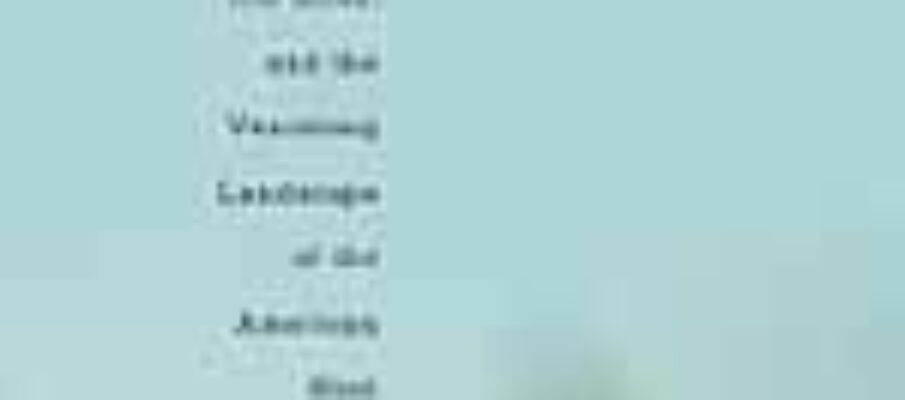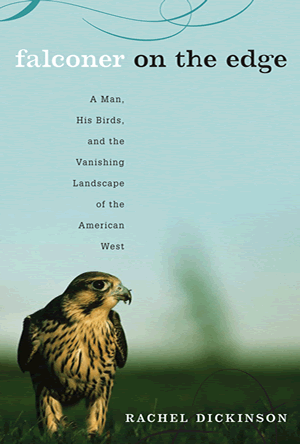As a metaphor, the image of an “edge” is one that can be understood in a wide variety of ways. One can be at the leading edge, the trailing edge, or just about to fall over the edge. It can imply marginalization, iconoclasm, or exceptionality. A person at the edge can be inside looking out or outside looking in, and a geographic region at the edge might be either that which is yet to be developed or what is left after all else has been. In Falconer on the Edge: A Man, His Birds, and the Vanishing Landscape of the American West, Rachel Dickinson’s depiction of falconer Steve Chindgren and the world in which he lives, nearly all these variations of meaning are shown as applicable to at least one aspect of this wonderfully rich and assumption-shattering tale.
Falconry, steeped as it is in tradition and solitary as its practice out of necessity must be, is an enigma wrapped in a mystery. Aside from the modern radio telemetry equipment used to locate a missing bird, most of the equipment used for the training of and hunting with birds of prey has remained relatively unchanged for centuries. Even its very language is heavily interwoven with words long since declared archaic. Indeed, were it not for the fact that Ms. Dickinson is married to a falconer herself, the noted ornithological editor Tim Gallagher, and lived at least at the margin of its practice for many years, it is doubtful that even someone of her considerable journalistic skill could have successfully come to understand it and as a result present such a deeply considered and complex narrative intelligible to the general reader. Fortunately, her finely honed interviewing and research skills, her exceptional writing talent, and her own life’s experience combine to yield a wholly enthralling view into the very heart of the little known yet fascinating world of falconry.
To describe falconry as a sport is to do it and its practitioners a gross injustice, for even the most ardent practitioner of a sport can put it aside from time to time when illness, exhaustion, or any one of a host of life’s urgent requirements deem a hiatus of its practice necessary; not so with falconry. Whether the falconer hunts with the smallest kestrel or the largest hawk, from the moment the two first come together, the bird and the human are bound by ties both practical as well as emotional. The falconer is not the owner of the bird (even legally) nor is the bird the servant – each is the partner of the other, both in the field as well as in life. However not only is there a mutual dependence between the bird and the falconer, there is a dependence of both upon the land and the other wildlife among which they live and hunt; in the case of this particular story, most prominent among this wildlife is the preferred quarry of Mr. Chindgren and the falcons with which he hunts – the Greater Sage-Grouse.
Like many of the iconic species of wildlife found in the western United States, the Greater Sage-Grouse is under considerable pressure. The habitat to which its life is inextricably linked, the sagebrush plains of the inland west, are in high demand by extractive industries such as oil and natural gas, as well as for the expansion of the suburbs surrounding the widely spaced yet growing western cities. In the face of these human desires, the undisturbed open expanses of sagebrush required by the grouse stand little chance of remaining as they are. And just as the lives of the grouse are inextricably linked to the sagebrush, the lives of Mr. Chindgren and the birds with which he hunts are linked to the grouse. As Ms. Dickinson so eloquently depicts, the relentless advance of both time and the modern world is pushing them all ever-closer to the edge.
Title: Falconer on the Edge: A Man, His Birds, and the Vanishing Landscape of the American West
Author: Rachel Dickinson
Publisher: Houghton Mifflin Harcourt
ISBN-13/EAN: 9780618806232
ISBN-10: 0618806237
Hardcover; 240 pages
In accordance with Federal Trade Commission 16 CFR Part 255, it is disclosed that the copy of the book read in order to produce this review was provided gratis to the reviewer by the publisher.
If you enjoyed reading this, please consider signing up for The Well-read Naturalist's newsletter. You'll receive a helpful list of recently published reviews, short essays, and notes about books in your e-mail inbox once each fortnight.


